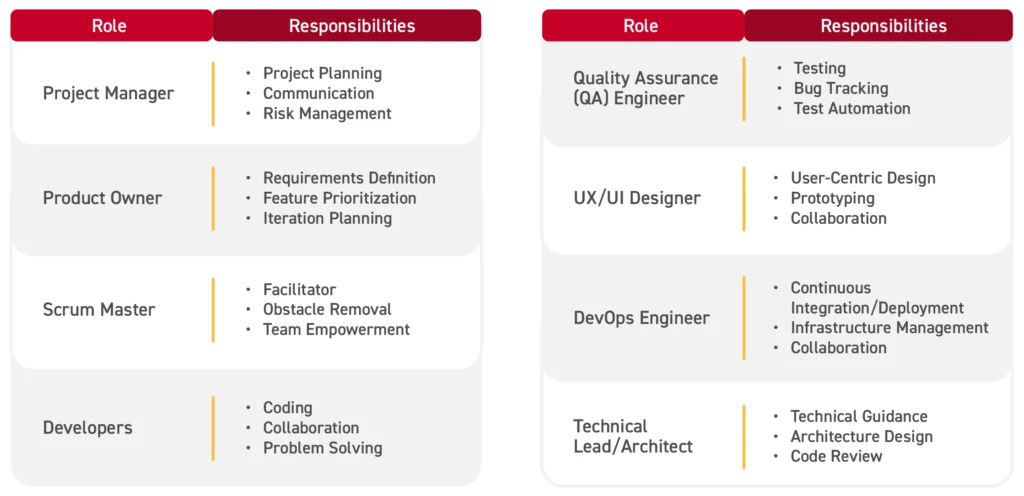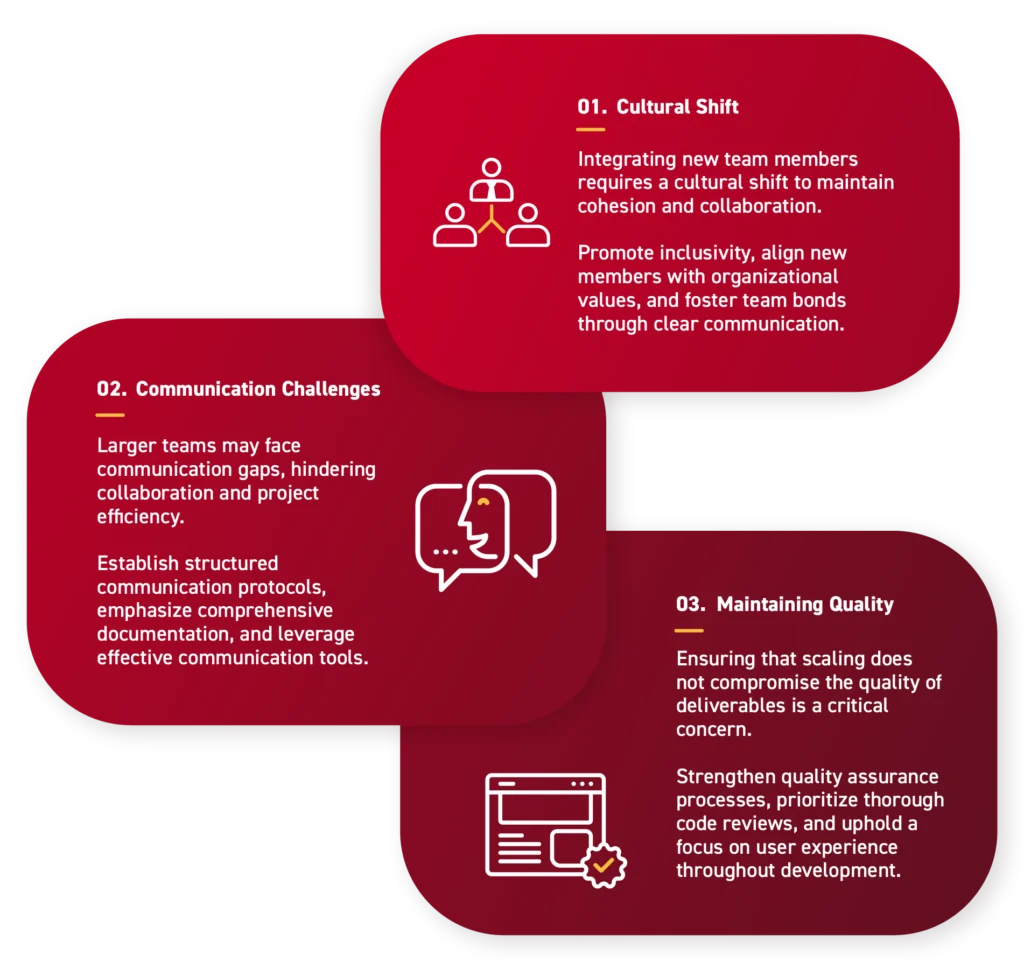

Scaling IT development teams is about balancing the desire to expand talent with maintaining agility, quality, and a vibrant team culture.
This process it is about fostering an environment where new and existing members can seamlessly integrate, collaborate effectively, and deliver exceptional software.
This article dives deep into the challenges of scaling IT development teams and explores strategies for building an inclusive and collaborative culture, navigating potential communication challenges, and ensuring that quality remains paramount throughout the scaling process.
Scaling in Software Development
Scaling in software development refers to the strategic expansion of a development team to meet the increasing demands and complexities of a growing project or business.
It involves increasing the number of team members and optimizing processes, workflows, and infrastructure to ensure sustained efficiency and effectiveness.
This expansion can encompass hiring new talent, adopting new technologies, and adjusting the overall structure to accommodate the evolving needs of the project or organization.
Why Is Scaling Important?
Scaling is a critical strategic decision directly impacting the organization’s ability to innovate, deliver products efficiently, and maintain a competitive edge.
Scaling allows technology leaders to ensure their teams can handle increased workloads and evolving project requirements. It enables technology leaders to build teams with the skills and expertise to spearhead innovative solutions.
Larger teams, when managed effectively, can enhance overall productivity by distributing tasks efficiently and leveraging diverse skills. This results in faster development cycles and more timely product releases.
Reasons to Scale Up a Dev Team
By recognizing the necessity of accelerating development cycles, organizations can strategically scale their development teams to keep pace with market demands and proactively shape industry trends.
Here are the main benefits and reasons why you should consider this strategy for your team.
Increased Workload
Recognizing the need to scale up a development team often begins with assessing the current workload. When the existing team finds it challenging to cope with the increasing demands of projects, deadlines, and tasks, it is a clear signal that scaling is necessary.
Work Overload Indicators
- Missed deadlines
- Increased overtime
- Quality compromises
Impact on Team Morale
- Burnout
- Employee turnover
- Client satisfaction
- Client feedback
Market Expansion
Scaling teams becomes essential to align with this expansion and address the evolving needs of the market:
Geographic Expansion
- Entering new markets
- Diversification of projects
- New product lines
- Specialized solutions
Competitive Edge
- Adapting to trends
Accelerating Development
Scaling up the development team becomes crucial to address the need for accelerated product development cycles:
Time-to-Market Pressures
- Industry dynamics.
- Competitive urgency
Scalability of Resources
- Parallel development
- Agile methodologies
Customer Expectations
- Meeting Client Expectations
Software Development Team Structure
A well-defined software development team structure is essential for efficient collaboration, clear communication, and successful project delivery.
Outlining key roles and responsibilities within the team establishes a framework that ensures each member contributes effectively to the overall development process. Here are some responsibilities for each role.

When Is the Best Time to Scale Software Development Teams? Here Is A Quick Checklist
Recognizing the opportune moment to scale a software development team is crucial for maintaining productivity, meeting project demands, and fostering a healthy work environment.
By keenly observing the following key indicators, technology leaders can make informed decisions about the right time to scale their software development teams.
Increased Workload
- Consistent failure to meet project milestones or deadlines may signal that the existing team is overwhelmed.
- Team members regularly working extended hours or weekends to keep up with workloads suggests an unsustainable situation.
Backlog Growth
- A growing backlog of tasks indicates that the team’s capacity is insufficient to handle the volume of work effectively.
- Persistent issues or tasks lingering in the backlog may indicate a need for additional resources.
Decline in Productivity
- A noticeable decline in team efficiency or individual productivity can be a clear sign of an overloaded team.
- Higher rates of defects or bugs in the software may indicate that the team is stretched thin, impacting the quality of deliverables.
Stakeholder Feedback
- Negative feedback from clients regarding project delivery times, product quality, or communication issues should prompt a reassessment of team capacity.
- A surge in change requests may indicate that the existing team is struggling to meet evolving project requirements.
Employee Burnout and Turnover
- A spike in employee burnout rates, manifested through absenteeism, decreased morale, or increased stress levels, signals potential staffing issues.
- If there’s a notable increase in employee turnover, it could be a consequence of an overworked team and unmet expectations.
Market Opportunities
- Identifying new business opportunities or markets but lacking the resources to pursue them can be a strong indicator for team expansion.
- If competitors are expanding or releasing products more rapidly, it may be time to scale to maintain competitiveness.
Technological Advancements
- The need to adopt new technologies or methodologies may require additional expertise not currently present in the team.
- Technological advancements that demand specialized skills, which the current team lacks, may necessitate expansion.
Strategic Planning and Growth Forecast
- Alignment of team expansion with broader organizational strategic objectives and growth plans.
- Anticipating future project demands and ensuring the team has the capacity to handle upcoming requirements.
Challenges of Scaling Software Development Teams

Tips for Scaling IT Development Teams
Implementing effective strategies during the scaling of IT development teams is crucial for success, you can count on our best tips for each step in the process:
Gradual Expansion
- Advocate for a phased approach to team scaling to minimize disruptions and ensure a smooth integration of new members.
- Initiate scaling with pilot projects, learning and adjusting strategies based on insights gained.
Talent Acquisition Strategies
- Clearly define skill requirements, diversify skill sets, and strategically hire individuals aligned with organizational goals.
- Also, actively participate in industry events, enhance company branding, and leverage networks to attract top-tier talent.
Continuous Training
- Regularly assess skill gaps, develop customized training plans, and encourage continuous learning for ongoing skill enhancement.
- Foster a culture of knowledge sharing through internal workshops, mentorship programs, and access to external training resources.
How to Prepare for Team Scaling: Business and Technical Perspectives
Preparing for team scaling requires a holistic approach that encompasses both business and technical considerations as the following:
Budgeting and Resource Allocation (Business Perspective)
- Ensure financial readiness for team expansion through detailed budgeting and resource allocation.
- Develop scalable budget models, anticipate resource needs, and include contingency funds.
ROI Analysis (Business Perspective)
- Conduct a thorough ROI analysis to justify and measure the impact of team scaling efforts.
- Define relevant KPIs, regularly monitor performance metrics, and adjust strategies based on ongoing analysis.
Stakeholder Communication (Business Perspective)
- Communicate transparently with key stakeholders about the benefits and objectives of team scaling.
- Provide regular updates on progress and highlight the positive impact of scaling efforts on projects and team dynamics.
Infrastructure Readiness (Technical Perspective)
- Evaluate the existing technical infrastructure for scalability to support team expansion.
- Conduct scalability assessments, implement necessary upgrades, and consider cloud solutions for enhanced scalability.
Technology Stack Assessment (Technical Perspective)
- Ensure the compatibility of the current technology stack with the expanded team’s requirements.
- Evaluate the current technology stack, address compatibility issues, and provide comprehensive onboarding programs for new team members.
Security Measures (Technical Perspective)
- Implement robust security measures to safeguard sensitive information during team scaling.
- Utilize encryption protocols, strict access controls, and conduct regular security awareness programs to mitigate potential risks.
A combined focus on business and technical perspectives ensures a comprehensive and strategic approach to team scaling, fostering a smooth integration of new members, maintaining quality, and optimizing the overall development process.
Avoiding Risks in Rapid Team Expansion
Scaling a team too quickly can bring forth numerous challenges and setbacks. It is crucial to avoid common pitfalls associated with rapid scaling to ensure a smooth and effective expansion process.
Organizations can successfully scale their teams without compromising productivity or team cohesion by navigating the following potential risks with strategic planning and focusing on cultural dynamics and communication. Here is what tech leaders must consider:
Inadequate Planning
Insufficient preparation is a primary risk in rapid team expansion.
Rushing into scaling without thorough planning can lead to chaos and inefficiencies. Additionally, this approach may compromise the quality of work, negatively impacting project outcomes.
Cultural Dilution
The risk of cultural dilution arises when new team members are rapidly integrated without a focus on cultural alignment.
This threatens the existing team culture, potentially leading to losing identity and impacting morale. Sudden changes can result in decreased job satisfaction and productivity.
Ignoring Cultural Dynamics
When building a software development team cultural dynamics play a pivotal role in team effectiveness, and neglecting these dynamics can hinder the scaling process.
To mitigate this risk, organizations should conduct a cultural assessment, understanding the existing team culture and dynamics before scaling. Companies should develop strategies to align new team members with the existing cultural values.
Communication Channels
Effective communication is vital during team scaling, and inadequate communication can lead to misunderstandings and inefficiencies.
Transparent communication is key to addressing cultural misunderstandings or conflicts promptly.
Implementing team-building initiatives further strengthens cultural bonds and fosters a collaborative environment.
Inadequate Communication
Mitigating the negative impact of poor communication is essential during the scaling process. To address this risk, organizations should ensure role clarity by defining roles and responsibilities clearly.
Utilizing the right communication platforms eases seamless interaction while establishing feedback mechanisms. Platforms facilitate seamless interaction while showing feedback mechanisms that encourage team members to express concerns, provide suggestions, and address issues.
Regular check-ins help assess communication effectiveness and make necessary adjustments for continuous improvement.
Optimizing Team Scaling: Best Practices for Software Development
By adhering to the following best practices, companies create a dynamic, adaptable, and continuously improving environment for scaled software development teams.
Leveraging data, embracing agile methodologies, and establishing effective feedback loops empower teams to navigate the complexities of scaling confidently and achieve sustained success.
Data-Driven Decision-Making
By defining Key Performance Indicators (KPIs) relevant to the scaling objectives, teams can continuously monitor these metrics.
This ongoing assessment gauges the impact of scaling on various aspects, including productivity and project outcomes. Incorporating user feedback into the decision-making process allows for iterative adjustments, ensuring a user-centric approach throughout development.
Agile Project Management
When managing a software development team, adopting agile methodologies provides a flexible and adaptive framework for managing projects during team scaling.
Embracing iterative planning through short sprints allows teams to address changing project requirements. The adaptability inherent in agile methodologies enables swift responses to evolving circumstances.
Implementing the Scrum framework further enhances collaboration, with regular reassessment of project priorities through daily stand-up meetings.
Feedback Loops
Establishing effective feedback loops is instrumental in identifying areas for improvement and promoting continuous growth.
Implementing 360-degree feedback mechanisms involving peers, subordinates, and supervisors ensures comprehensive feedback.
Regular individual and team assessments based on this feedback contribute to ongoing performance evaluations. Conducting retrospectives allows teams to reflect on project outcomes, team dynamics, and processes, translating insights into actionable improvements for future projects.
Embrace Success Today with Us!
With a history of empowering technology leaders and enterprises, we offer expertise and resources to streamline your scaling initiatives.
Our team of experts understands the unique challenges and opportunities associated with scaling and provides strategic guidance tailored to your organizational needs.
Contact us today to discuss how we can help elevate your scaling initiatives and propel your organization to new heights. Your success is our top priority!





